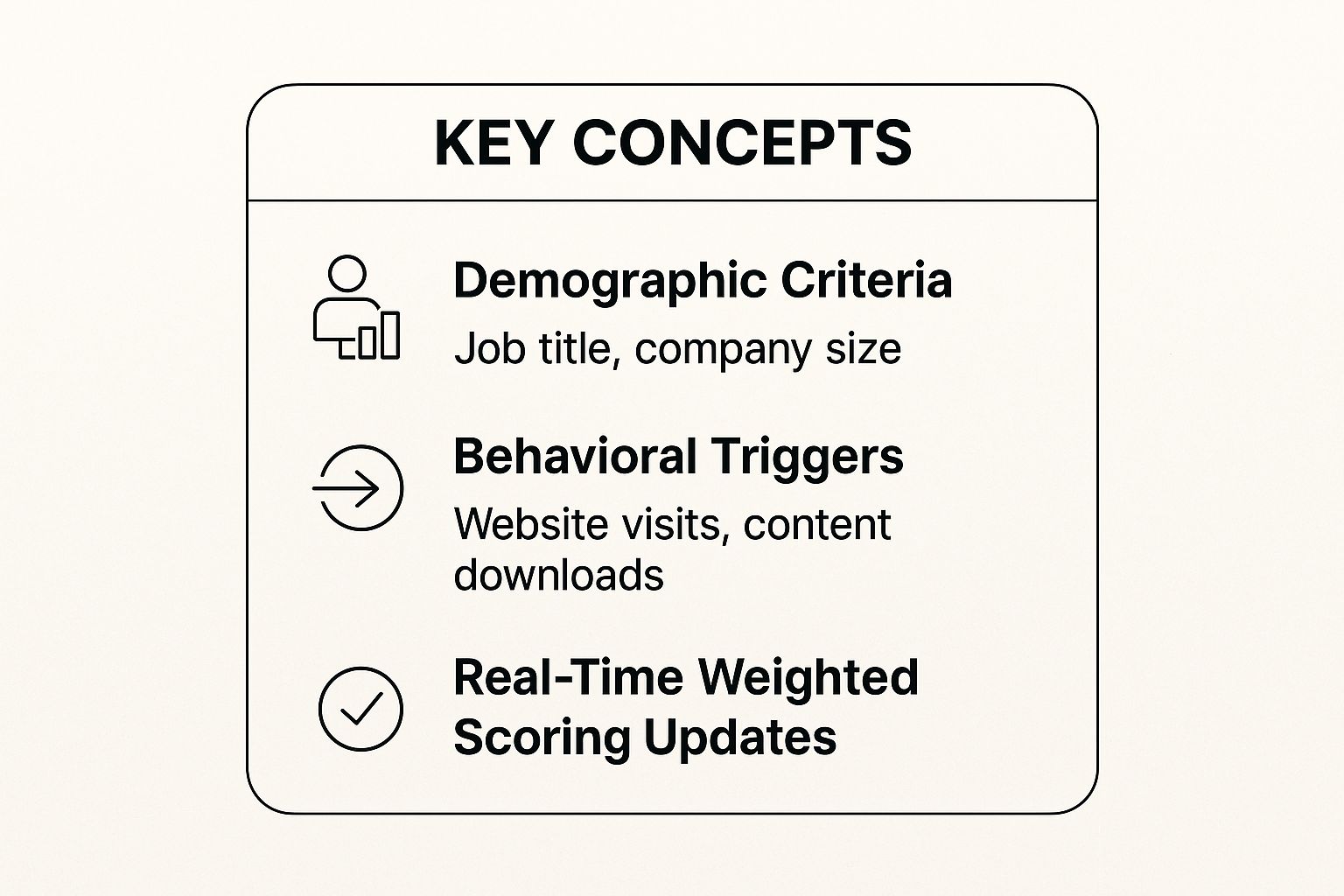In the competitive B2B landscape, simply collecting leads isn't enough. The real challenge, and opportunity, lies in identifying which prospects are ready for a conversation and which need more nurturing. This is where a sophisticated lead scoring system transforms from a marketing 'nice-to-have' into a revenue-driving engine. However, many teams rely on outdated, static models that leak value and create friction between sales and marketing. A generic approach leads to sales teams wasting time on unqualified prospects while high-potential leads go cold.
This guide moves beyond generic advice to provide a detailed roadmap of advanced lead scoring best practices. We'll explore how to build a dynamic, data-driven framework that not only prioritizes leads with precision but also aligns your entire go-to-market team. Forget surface-level tips; you'll get actionable strategies you can implement immediately.
Here’s what this roundup covers:
- Integrating predictive AI and third-party intent data.
- Building persona-based models and implementing negative scoring.
- Establishing clear governance to keep your system optimized.
These eight strategies are designed for B2B outreach teams looking to maximize efficiency, accelerate their sales cycle, and drive predictable growth. Prepare to refine your process and turn your lead queue into a powerful pipeline.
1. Implement Behavioral and Demographic Scoring Models
The foundation of any robust lead scoring system lies in combining two critical data dimensions: demographic information and behavioral activity. Relying on only one provides an incomplete picture. A lead might perfectly match your ideal customer profile (ICP) but show zero interest, while another might be highly engaged but not be a good fit for your product. One of the most effective lead scoring best practices is to merge these two streams to create a holistic, dual-axis scoring model that evaluates both fit and interest.
This approach, popularized by marketing automation pioneers like HubSpot and Marketo, ensures your sales team prioritizes leads who are not only a good match for your business but are also actively demonstrating purchase intent.
How Dual-Axis Scoring Works
A dual-axis model assigns separate scores for demographic attributes and behavioral triggers, which can then be combined into a single, comprehensive lead score.
-
Demographic Scoring (Fit): This score qualifies how well a lead matches your ICP. Points are awarded based on explicit data provided by the lead or enriched from third-party sources. Key criteria include job title, industry, company size, and geographic location. For example, a "Director of Marketing" at a 500-person SaaS company might receive a high demographic score, while an "Intern" from a non-target industry would receive a low one.
-
Behavioral Scoring (Interest): This score measures a lead's engagement with your brand. Points are assigned for specific actions that indicate active interest, such as visiting your pricing page, downloading a case study, or attending a webinar. The more high-value actions a lead takes, the higher their behavioral score.
This infographic breaks down the core components of this combined scoring model.

By tracking both fit and interest criteria and updating scores in real-time, you create a dynamic system that accurately reflects a lead's current value to your sales team.
Practical Implementation Tips
To effectively implement this model, start simple and build complexity over time.
- Establish a Baseline: Begin by identifying 3-5 key demographic attributes and 5-7 high-intent behaviors. Assign a simple point system (e.g., 1-10 points) for each.
- Introduce Negative Scoring: Penalize actions that signal a lack of fit or interest. For instance, subtract points if a lead unsubscribes from your newsletter, visits your "Careers" page, or has an email address from a competitor's domain.
- Set Clear Thresholds: Define what constitutes a Marketing Qualified Lead (MQL). For example, you might set the MQL threshold at a combined score of 75, or require a minimum score in both demographic (e.g., 30+) and behavioral (e.g., 40+) categories.
- Review and Refine: Regularly analyze the deals that have closed. Do your highest-scoring leads consistently convert into customers? Use this data to adjust your scoring criteria and point values to improve accuracy.
2. Align Sales and Marketing on Lead Definitions
One of the most critical, yet often overlooked, lead scoring best practices is achieving complete alignment between sales and marketing teams. Without a shared understanding of what constitutes a "good lead," even the most sophisticated scoring model will fail. The foundation of a successful handoff is an effective lead qualification process, which requires clear, mutually agreed-upon definitions for Marketing Qualified Leads (MQLs) and Sales Qualified Leads (SQLs).
This alignment, often called "smarketing" and popularized by platforms like HubSpot and Salesforce, ensures that marketing delivers leads sales actually wants to work. It eliminates the common friction point where sales complains about lead quality and marketing feels its efforts are wasted. Companies like Microsoft have seen a 38% increase in sales win rates simply by improving this collaboration.
How MQL and SQL Alignment Works
This practice involves creating a formal agreement, or a Service Level Agreement (SLA), that documents the precise criteria a lead must meet to pass from one stage to the next.
-
Marketing Qualified Lead (MQL): This definition is owned by marketing but created with significant input from sales. It specifies the exact combination of demographic fit and behavioral engagement required for a lead to be considered ready for sales outreach. For example, an MQL might be a "Director" from a "SaaS" company who has downloaded a "Case Study" and visited the "Pricing Page."
-
Sales Qualified Lead (SQL): This definition is owned by sales. It outlines the criteria a lead must meet after the initial sales conversation to be considered a legitimate, viable opportunity. This typically involves confirming budget, authority, need, and timeline (BANT). Sales agrees to accept and work all MQLs that meet the predefined criteria, providing feedback on their quality.
This framework transforms lead scoring from a theoretical marketing exercise into a practical, revenue-driving process that both teams trust.
Practical Implementation Tips
To bridge the gap between your sales and marketing teams, focus on communication and documentation.
- Establish a Feedback Loop: Create a formal process for the sales team to provide regular feedback on the quality of MQLs. This can be done through a dedicated Slack channel, CRM fields, or weekly meetings.
- Document Everything: Codify your MQL and SQL definitions in a shared document. This "Smarketing SLA" should be easily accessible to everyone on both teams and serve as the single source of truth.
- Hold Regular Alignment Meetings: Schedule bi-weekly or monthly meetings dedicated to reviewing lead quality, conversion rates, and the MQL/SQL definitions. Use data, not anecdotes, to drive discussions and adjustments.
- Review and Update Definitions: Your business evolves, and so should your lead definitions. Revisit the criteria quarterly to ensure they still reflect your ideal customer and their buying journey. For instance, if you notice leads who attend webinars are converting at a high rate, you might increase the score for that action.
3. Use Predictive Lead Scoring with Machine Learning
While traditional rule-based systems are a powerful starting point, one of the most advanced lead scoring best practices is to leverage predictive models. Predictive lead scoring uses machine learning algorithms to analyze vast amounts of historical data, identifying subtle patterns and correlations that human-defined rules often miss. This approach moves beyond simple "if-then" logic to calculate a lead's conversion probability with far greater accuracy.
Platforms like Salesforce Einstein and 6sense pioneered this method, creating systems that continuously learn from new data. As more leads convert into customers or are disqualified, the model refines its understanding of what truly makes a high-value prospect, ensuring your scoring remains dynamic and effective over time.

How Predictive Scoring Works
Predictive models analyze your historical sales data, including both won and lost deals, to build a "success profile." The algorithm identifies the specific combination of demographic, firmographic, and behavioral attributes that most strongly correlate with conversion.
-
Data Analysis: The model ingests thousands of data points, far more than a manual system could handle. This includes standard fields like job title and company size, as well as nuanced signals like technology stack, website engagement patterns, and content consumption velocity.
-
Probability Score: Instead of assigning arbitrary points, the system generates a predictive score, often on a 1-100 scale, representing the statistical likelihood that a lead will convert. A score of 95 means the lead shares characteristics with 95% of your past successful customers.
This data-driven approach removes guesswork and internal biases, allowing sales teams to focus on leads that are statistically proven to be the most promising.
Practical Implementation Tips
Transitioning to predictive scoring requires a strategic approach and sufficient data to be effective.
- Ensure Data Sufficiency: Predictive models need a large dataset to learn from. A common guideline is to have at least 1,000 closed deals (both won and lost) for the algorithm to build an accurate initial model.
- Start with a Pilot Program: Before a full-scale rollout, test the predictive model with a small segment of your sales team. This allows you to validate its accuracy against real-world outcomes and gather feedback.
- Combine with Human Insight: A predictive score is a powerful indicator, but it should not completely replace human judgment. Encourage reps to use the score as a guide while still applying their own expertise and context to conversations.
- Monitor for Model Drift: Your market, product, and ideal customer profile can change over time. Regularly monitor the model's performance and be prepared to retrain it with fresh data to prevent its predictions from becoming outdated or inaccurate.
4. Implement Time-Decay Scoring
A lead's engagement from six months ago is not as valuable as their engagement from last week. One of the most critical lead scoring best practices is to implement time-decay scoring, a system that reduces the value of older activities over time. This ensures that lead scores reflect current interest levels, preventing sales teams from chasing leads who have long since gone cold despite a historically high score.
This methodology, championed by marketing automation platforms like Marketo and Pardot, keeps your lead queue fresh and relevant. It prioritizes leads who are actively showing recent buying signals, which is a far more accurate indicator of sales readiness than a collection of outdated actions.
How Time-Decay Scoring Works
Time-decay scoring automatically diminishes the point value of behavioral actions as they age. Instead of an activity providing a permanent score boost, its value gradually erodes until it eventually expires, ensuring that a lead's score is a dynamic reflection of their present engagement.
- Initial Action: A lead downloads a whitepaper and receives +15 points.
- Decay Period: You set a decay rule to reduce the score by 5 points every 30 days for this type of action.
- Score Adjustment: After 30 days, the score from that action drops to +10. After 60 days, it becomes +5. After 90 days, the points from that specific download expire completely.
This process ensures that a lead must continue to engage with your brand to maintain a high score. It accurately separates the actively interested from the historically curious, allowing your sales team to focus its energy where it matters most.
Practical Implementation Tips
To apply time-decay effectively, align the decay rates with your business's natural sales rhythm.
- Align with Your Sales Cycle: Set decay periods based on your average sales cycle length. If your cycle is 90 days, you might have scores fully decay after 120 days of inactivity to catch outliers.
- Vary Rates by Activity: High-intent actions like a "Request a Demo" click could have a slower decay rate than lower-intent actions like a blog visit. This preserves the importance of significant buying signals for longer.
- Monitor Score Drops: Create alerts for high-value leads whose scores drop significantly due to decay. This is a perfect trigger to enroll them in a re-engagement or nurturing campaign to rekindle their interest.
- Test and Optimize: Experiment with different decay rates and periods. Analyze whether tightening or loosening these rules leads to better conversion rates and adjust your strategy based on the performance data.
5. Create Persona-Based Scoring Models
A one-size-fits-all lead scoring model can be a major blind spot, as it assumes all prospects behave identically. The reality is that different buyer personas exhibit unique behaviors, follow distinct conversion paths, and respond to different triggers. One of the most advanced lead scoring best practices is to develop separate, persona-based scoring models that acknowledge these crucial nuances and score leads based on criteria relevant to their specific role and journey.
This sophisticated approach moves beyond a single set of rules, creating tailored models that more accurately reflect the value of a lead within a specific market segment. For instance, the actions that signal purchase intent for an IT Director are vastly different from those of a Marketing Manager. Persona-based scoring ensures you don't overlook a high-value lead just because their behavior doesn't fit a generic profile.

How Persona-Based Scoring Works
Persona-based scoring involves creating multiple, parallel scoring systems, each designed for a specific buyer persona. When a new lead enters your system, they are first assigned to a persona, and then their activity is measured against that persona's unique scoring criteria.
- IT Director Persona: This model might heavily weigh behaviors like downloading technical whitepapers, viewing API documentation, or attending a product integration webinar. Demographic factors like company size and existing tech stack would be critical.
- Marketing Manager Persona: This model would assign higher scores for engaging with case studies, calculating ROI on your website's savings calculator, or registering for a marketing strategy webinar. Job titles and industry would be key demographic indicators.
Companies like Adobe and Microsoft successfully use this method to differentiate between technical and business stakeholders, ensuring each lead is nurtured and evaluated according to the most relevant metrics. This segmentation prevents sales teams from misinterpreting a lead's intent.
Practical Implementation Tips
Implementing persona-based scoring requires a deep understanding of your audience and a structured approach.
- Define and Prioritize Personas: Start by developing 2-3 of your most distinct and valuable buyer personas. Use historical data to identify their unique behavioral patterns and conversion triggers. To effectively segment your audience and build robust persona-based models, consider applying principles from powerful customer discovery interview questions.
- Establish Persona-Specific Rules: For each persona, define unique scoring rules. What actions and attributes are most predictive of a sale for this specific group? Assign points, including negative scores, accordingly.
- Automate Persona Assignment: Use automation rules in your CRM or marketing platform to assign new leads to the correct persona based on initial data like job title, industry, or form submission answers.
- Iterate and Validate: Regularly analyze the performance of each persona-based model. Are the leads being qualified converting at a higher rate? Use this feedback to refine your persona definitions and scoring criteria. Learn more about how to create a detailed buyer persona on Salesloop.io.
6. Incorporate Negative Scoring Factors
While most lead scoring models focus on rewarding positive actions, one of the most impactful lead scoring best practices is to actively penalize signals of poor fit or disinterest. Incorporating negative scoring factors is essential for filtering out unqualified leads, such as students, job seekers, or competitors, ensuring your sales team doesn’t waste time on prospects who will never convert. It adds a crucial layer of qualification that purges low-quality contacts from your high-priority queue.
This strategy sharpens the accuracy of your overall score by acknowledging that not all engagement is created equal. A lead who downloads ten ebooks but works for a direct competitor is far less valuable than a lead from a target account who only visited your pricing page once. Negative scoring helps your system make that critical distinction automatically.
How Negative Scoring Works
Negative scoring involves assigning negative point values to specific attributes or behaviors that indicate a lead is a poor fit or is losing interest. This systematically lowers their score, pushing them down the priority list or even disqualifying them entirely.
-
Disqualifying Attributes: This involves subtracting points for demographic or firmographic data that falls outside your ideal customer profile (ICP). For example, you might deduct points for leads using personal email domains (like Gmail or Yahoo) in a B2B context, or for those located in geographic regions your company doesn't serve.
-
Disengaging Behaviors: This focuses on actions that signal a lack of genuine purchase intent. A classic example is subtracting points when a lead unsubscribes from your email list or visits your "Careers" page. Other signals include long periods of inactivity or marking your emails as spam.
By implementing these rules, you create a self-cleaning mechanism within your lead management process, preventing sales reps from chasing dead ends and improving overall pipeline health.
Practical Implementation Tips
To effectively use negative scoring without being overly aggressive, follow these guidelines.
- Start with Obvious Disqualifiers: Begin by identifying clear-cut negative signals. Deduct significant points for competitor email domains, student email addresses (.edu), or visits to your careers page. These are easy to justify and have a high impact.
- Balance Negative and Positive Scores: Ensure your model is balanced. A single negative action, like an unsubscribe, shouldn't completely nullify a history of high-intent positive engagement. The goal is to refine scores, not zero them out prematurely.
- Create Separate Workflows: Route leads who accumulate a significant negative score (e.g., -50 or more) into a separate "disqualified" or "low-priority nurture" workflow. This keeps them out of the active sales pipeline but retains their data for future analysis.
- Audit and Validate Regularly: Review your negative scoring rules quarterly. Are they too harsh? Are they correctly identifying unqualified leads? Analyze a sample of negatively scored leads to confirm they were indeed a poor fit, and adjust your criteria accordingly.
7. Establish Lead Scoring Governance and Regular Optimization
A lead scoring model is not a "set it and forget it" tool. One of the most critical lead scoring best practices is to establish a formal governance process for managing, monitoring, and continuously improving your model. Markets shift, customer behaviors evolve, and your own business goals change. Without regular optimization, even the most thoughtfully designed scoring system will lose its accuracy and effectiveness over time, leading to misaligned sales and marketing efforts.
This systematic approach, championed by modern Revenue Operations (RevOps) and marketing operations teams, transforms lead scoring from a static project into a dynamic, living system. It ensures your model remains a reliable predictor of sales readiness and continues to deliver high-quality leads to your sales team.
How Lead Scoring Governance Works
Lead scoring governance creates a structured framework for the ongoing maintenance of your scoring model. It involves scheduling regular reviews, analyzing performance data, and making data-driven adjustments. This prevents "scoring decay," where the criteria that once signaled a hot lead no longer hold true.
- Regular Cadence of Review: Governance establishes a predictable schedule for analysis. This typically involves monthly check-ins between sales and marketing to discuss lead quality and quarterly deep-dives into performance data to identify necessary adjustments.
- Performance Monitoring: This involves tracking key metrics to measure the model's health. The most important metric is the correlation between lead scores and actual conversion rates. A strong model will show that leads with higher scores consistently close at a higher rate.
- Iterative Refinement: Based on performance data and qualitative feedback from the sales team, you can make informed changes. This could be as simple as adjusting point values for a specific action or as significant as overhauling entire scoring categories.
By implementing a governance structure, you create a feedback loop that ensures your lead scoring model adapts to real-world results and consistently helps you prioritize the most valuable sales leads.
Practical Implementation Tips
A strong governance plan is built on process, documentation, and collaboration.
- Schedule Recurring Meetings: Put monthly and quarterly review meetings on the calendar and treat them as non-negotiable. Involve key stakeholders from both sales and marketing to ensure all perspectives are heard.
- Create a Change Log: Document every modification made to the scoring model. Note what was changed, why it was changed, who approved it, and the date. This log is invaluable for tracking the evolution of your model and understanding the impact of adjustments.
- Leverage Sales Feedback: Your sales team is on the front lines. Regularly ask them about the quality of the leads they are receiving. Are MQLs genuinely ready for a sales conversation? Their anecdotal insights are a crucial complement to quantitative data.
- A/B Test Thresholds: Don't just guess the right MQL score threshold. Test different levels. For instance, send leads with a score of 75+ to sales for one month, and 85+ the next month, then compare the pipeline and conversion results.
8. Integrate Intent Data for Enhanced Scoring
While behavioral scoring tracks how leads interact with your owned assets like your website and emails, it misses a huge part of the buyer's journey: their research activity across the wider web. One of the most advanced lead scoring best practices is to integrate third-party intent data to gain visibility into these external buying signals. This allows you to identify accounts actively researching solutions like yours, even before they visit your site.
This strategy was pioneered by companies like Bombora and has become a cornerstone of modern account-based marketing (ABM) platforms like 6sense and TechTarget. By tapping into this data, you can uncover "in-market" buyers who are evaluating competitors or exploring topics directly related to the problems you solve, giving you a critical head start.
How Intent Data Works
Intent data providers aggregate and analyze content consumption from millions of B2B web properties, identifying when specific companies (accounts) are showing an unusual spike in research around certain topics. This provides a powerful layer of predictive insight on top of your existing scoring model.
-
Topic-Based Signals: Instead of just tracking a page view on your site, intent data alerts you when an account is heavily consuming articles, whitepapers, and reports related to keywords like "cybersecurity compliance" or "sales automation software" anywhere on the web.
-
Surge Identification: The core value lies in identifying a "surge" in activity. A single article read isn't a strong signal, but when multiple employees from the same company suddenly begin researching a relevant topic, it indicates a high probability of active purchase consideration. For a deeper understanding of how this works, you can learn more about B2B intent data on salesloop.io.
By incorporating these external signals, you move from a reactive to a proactive scoring model, identifying potential customers at the very beginning of their buying cycle.
Practical Implementation Tips
Integrating intent data requires a strategic approach to ensure a positive return on investment.
- Start with a Pilot Program: Before a full rollout, test intent data with a specific segment of your market. Identify a handful of high-value topics critical to your solution and monitor the results to validate its impact on lead quality.
- Combine with Other Data: Intent signals are most powerful when combined with your existing demographic and behavioral scores. A lead from a target account (good demographics) showing an intent surge (external signal) and visiting your pricing page (internal behavior) is an extremely high-priority lead.
- Set Appropriate Weights: Not all intent signals are equal. A surge on a broad topic might be worth 10 points, while a surge on a direct competitor's name or a "bottom-of-funnel" keyword could be worth 30 points.
- Train Your Sales Team: Sales reps need to understand what an intent signal means and how to use it. Provide them with talk tracks that reference the prospect's likely challenges based on their research activity, enabling more relevant and timely outreach.
Lead Scoring Best Practices Comparison
| Item Title | Implementation Complexity 🔄 | Resource Requirements ⚡ | Expected Outcomes 📊 | Ideal Use Cases 💡 | Key Advantages ⭐ |
|---|---|---|---|---|---|
| Implement Behavioral and Demographic Scoring Models | High – Data collection and integration intensive | High – Requires data sources & CRM integration | Improved lead qualification and conversion | Complex lead environments with multiple touchpoints | Accurate scoring combining fit & interest |
| Align Sales and Marketing on Lead Definitions | Medium – Requires coordination & documentation | Medium – Time for meetings and alignment efforts | Reduced friction, better lead handoff quality | Teams with misaligned sales & marketing metrics | Clear shared definitions increase ROI |
| Use Predictive Lead Scoring with Machine Learning | Very High – Needs data science expertise | Very High – Historical data & ML tools | Highly accurate predictive lead scoring | Organizations with large data and AI capability | Automated, adaptive, and scalable scoring |
| Implement Time-Decay Scoring | Medium – Configuring decay rates can be tricky | Medium – Setup in scoring systems | Reflects current engagement, avoids stale leads | Sales cycles where recent activity matters most | Maintains score relevance over time |
| Create Persona-Based Scoring Models | High – Multiple models and persona analysis | High – Deep persona research and data segmentation | Personalized lead qualification per persona | Businesses with diverse buyer personas | Tailored scoring improves conversion rates |
| Incorporate Negative Scoring Factors | Medium – Calibrating negatives carefully | Medium – Ongoing rule adjustment | Filters out poor-fit leads effectively | Improving lead quality by excluding low-value leads | Enhances sales efficiency and focus |
| Establish Lead Scoring Governance and Regular Optimization | Medium – Needs ongoing management and buy-in | Medium – Dedicated team time | Continual scoring improvements and alignment | Organizations requiring accurate, evolving scoring | Data-driven, sustainable scoring accuracy |
| Integrate Intent Data for Enhanced Scoring | High – Complex data integration & privacy concerns | High – Third-party data and platform costs | Early identification of buyer intent | ABM and sales teams needing competitive intelligence | Captures signals beyond owned channels |
From Scoring to Scaling: Your Next Steps in Outreach Automation
We have journeyed through a comprehensive collection of lead scoring best practices, moving from foundational concepts to advanced, AI-driven strategies. You now have the blueprint to transform your B2B outreach from a game of chance into a calculated science. By implementing a sophisticated scoring system, you are no longer just collecting leads; you are actively identifying future customers and prioritizing your team's most valuable asset: their time.
The core lesson from this exploration is that effective lead scoring is not a static, one-time setup. It is a dynamic, living system that thrives on continuous improvement and strategic alignment. It requires a commitment to collaboration between sales and marketing, a willingness to embrace new technologies like machine learning, and a disciplined approach to governance and optimization.
Key Takeaways for Immediate Impact
Let's distill the most critical insights from our listicle into actionable takeaways. Mastering these concepts will form the bedrock of a successful lead scoring framework:
- Hybrid Models are Superior: Relying on demographic data alone is a recipe for missed opportunities. The most powerful systems combine demographic attributes (who the lead is) with behavioral signals (what the lead does). This dual-lens approach provides a complete picture of a lead's fit and interest.
- Alignment is Non-Negotiable: A scoring model built in a marketing silo is destined to fail. The process of aligning on a "Marketing Qualified Lead" (MQL) and "Sales Qualified Lead" (SQL) definition forces crucial conversations that bridge the gap between teams, ensuring everyone is working toward the same revenue goals.
- Data Freshness Matters: Stale data leads to stale outreach. Implementing time-decay scoring, where points diminish over time, ensures that your sales team is always engaging with leads who have shown recent, relevant interest. This simple adjustment dramatically increases the timeliness and effectiveness of your follow-ups.
- Negative Scoring is a Filter for Quality: Just as important as identifying good leads is the ability to disqualify bad ones. Negative scoring for competitor domains, student email addresses, or disengaged behaviors acts as a powerful filter, preventing low-quality leads from ever reaching your sales reps and cluttering the pipeline.
Bridging the Gap from Intelligence to Action
Adopting these lead scoring best practices is a monumental step forward, but it's only half the battle. The ultimate purpose of a world-class scoring system is to trigger swift, intelligent, and personalized action. The most meticulously scored lead is worthless if they aren't engaged promptly and effectively. This is the crucial bridge you must cross: the transition from scoring to automated execution.
The true power lies in creating a seamless connection where high-scoring leads, identified through your predictive models and intent data integrations, are automatically funneled into personalized outreach sequences. Imagine a lead from a target-account persona visiting your pricing page and downloading a case study. Your system scores them, qualifies them as sales-ready, and instantly enrolls them in a multi-channel campaign tailored to their industry and expressed pain points. This is the future of B2B sales.
This synergy between intelligent scoring and automated execution is precisely how organizations scale their pipeline and build a predictable revenue engine. By implementing these practices, you are not just optimizing a single metric or process. You are fundamentally building a more efficient, data-driven, and powerful machine for growth, freeing your sales team to do what they do best: build relationships and close deals. The journey from scattered outreach to a targeted, automated system begins with the robust scoring foundation you now know how to build.
Ready to put your lead scoring intelligence into action? Salesloop.io helps you turn high-scoring leads into active conversations by automating personalized, multi-channel outreach sequences. Integrate your lead data and let Salesloop.io handle the execution, ensuring no high-value prospect ever slips through the cracks.





